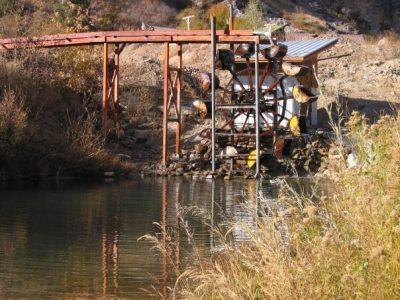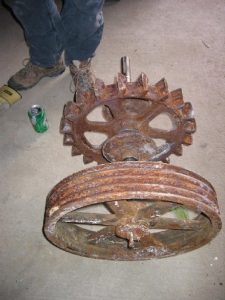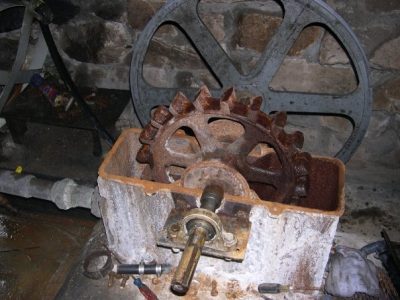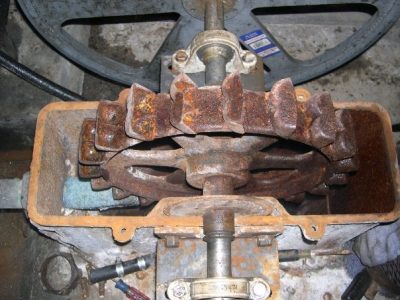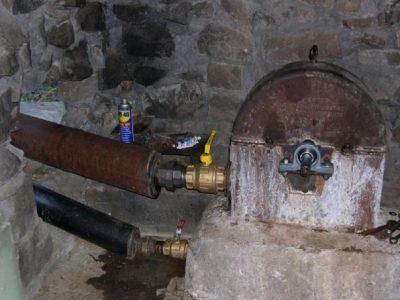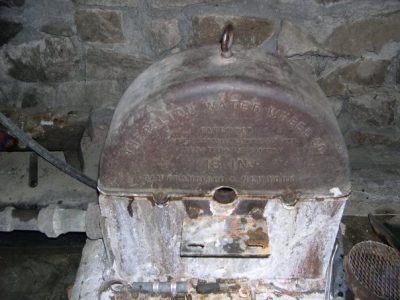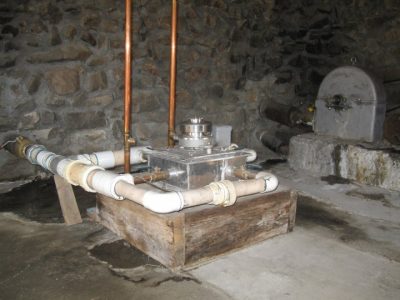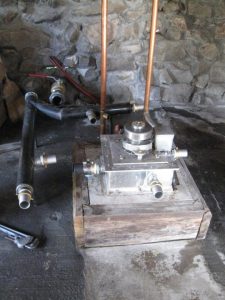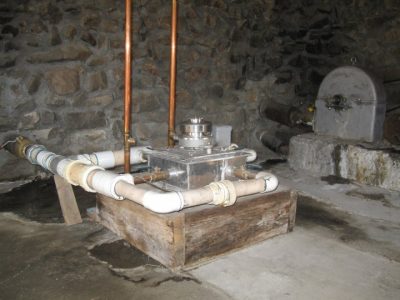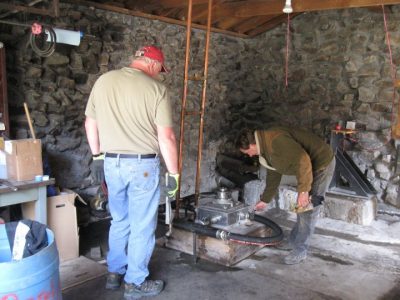Steve Acarregui of Power Systems Inc. for without his help we would have never got this project off the ground let alone going in the right direction, and for his flawless installation of the inverters and battery packs. I could (and did) call or send Steve endless emails asking questions, bouncing ideas off of him and he would always respond promptly and patiently. You can reach Steve @ 208-859-0874 to help install your new system!
Gary Soloman; the best welder out there! Thank you for braving the "groves " of poison Ivy to weld together the pipelines and tanks. The best part of his job was welding 75+ year old metal pipe that isn't quite as thick as today's metal pipe standards. Did I mention that 90% of the welding was done on hillsides of 30degree slopes, with poison ivy, and in hot summer days? Thanks again Gary! Maybe I should also thank the forest service for only giving Gary and I a warning and not a ticket for welding the same day that the "burn ban" went in to effect. (We had fire extinguishers on site and nearby.)
Idaho Dept. of Water Resources for their wealth of information and incentive programs to get projects like mine off the ground.
Jim Crawford at Wells Fargo bank for supplying us with the loan. We promise to pay it back someday!
Finally- thanks to all my friends who watched amusingly thinking I would never get full time power but secretly hoping I would; of course a little more thanks goes to the few that helped. - S.C.
- PELTONBRACKET sheet 1 (1).pdf
- PELTONBRACKET SHEET 3 (1).pdf
- PELTONBRACKET SHEET 4 (1).pdf
- PELTONBRACKET SHEET 5 (1).pdf
- PELTONBRACKET SHEET 6 (1).pdf
- PELTONBRACKET SHEET 7 (1).pdf
- TWNWTRpwr Layout1 (1).pdf
Small Hydropower Systems
If you're considering building a small hydropower system on water flowing through your property, you have a long tradition from which to draw your inspiration. Two thousand years ago, the Greeks learned to harness the power of running water to turn the massive wheels that rotated the shafts of their wheat flour grinders. And in the hydropower heyday of the 18th century, thousands of towns and cities worldwide were located around small hydropower sites.
Uses of Hydropower
In the United States today, hydropower projects provide 81 percent of the nation's renewable electricity generation and about 10 percent of the nation's total electricity. That's enough to power 37.8 million homes, according to the National Hydropower Association.
The vast majority of the hydropower produced in the United States comes from large-scale projects that generate more than 30 megawatts (MW)enough electricity to power nearly 30,000 households. Small-scale hydropower systems are those that generate between .01 to 30 MW of electricity. Hydropower systems that generate up to 100 kilowatts (kW) of electricity are often called microhydro systems. Most of the systems used by home and small business owners would qualify as microhydro systems. In fact, a 10 kW system generally can provide enough power for a large home, a small resort, or a hobby farm.
Is Hydropower Right for You?
Of course to build a small hydropower system, you need access to flowing water. A sufficient quantity of falling water must be available, which usually, but not always, means that hilly or mountainous sites are best.
Next you'll want to determine the amount of power that you can obtain from the flowing water on your site. The power available at any instant is the product of what is called flow volume and what is called head.
Determining Head
Head is the vertical distance that water falls. It's usually measured in feet, meters, or units of pressure. Head also is a function of the characteristics of the channel or pipe through which it flows.
Most small hydropower sites are categorized as low or high head. The higher the head the better because you'll need less water to produce a given amount of power, and you can use smaller, less expensive equipment. Low head refers to a change in elevation of less than 10 feet (3 meters).
Economics of a small system
If you determine that your site is feasible for a small hydropower system, the next obvious step is to determine whether it makes sense economically to undertake building a system.
Add up all the estimated costs of developing and maintaining the site over the expected life of your equipment, and divide the amount by the system's capacity in watts. This will tell you how much the system will cost in dollars per watt. Then you can compare that to the cost of utility-provided power or other alternative power sources.
Whatever the upfront costs, a hydroelectric system will typically last a long time and, in many cases, maintenance is not expensive. In addition, there are a variety of financial incentives available on the state, utility, and federal level for investments in renewable energy systems. They include income tax credits, property tax exemptions, state sales tax exemption, loan programs, and special grant programs, among others. Contact your state energy office to see if your project may qualify for any incentives (see NASEO and DSIRE in "Resources" below). System Components
Small run-of-the-river hydropower systems consist of these basic components:
Water conveyance channel, pipeline, or pressurized pipeline (penstock) that delivers the water
Turbine or waterwheel transforms the energy of flowing water into rotational energy
Alternator or generator transforms the rotational energy into electricity
Regulator controls the generator
Wiring delivers the electricity.
Many systems also use an inverter to convert the low-voltage direct current (DC) electricity produced by the system into 120 or 240 volts of alternating current (AC) electricity (alternatively you can buy household appliances that run on DC electricity).
Some systems also use batteries to store the electricity generated by the system, although because hydro resources tend to be more seasonal in nature than wind or solar resources, batteries may not always be practical for hydropower systems. If you do use batteries, they should be located as close to the turbine as possible because it is difficult to transmit low-voltage power over long distances.
Turbines and waterwheels
The waterwheel is the oldest hydropower system component. Waterwheels are still available, but they aren't very practical for generating electricity because of their slow speed and bulky structure.
Turbines are more commonly used today to power small hydropower systems. The moving water strikes the turbine blades, much like a waterwheel, to spin a shaft. But turbines are more compact in relation to their energy output than waterwheels. They also have fewer gears and require less material for construction. There are two general classes of turbines: impulse and reaction.
Impulse
Impulse turbines, which have the least complex design, are most commonly used for high head microhydro systems. They rely on the velocity of water to move the turbine wheel, which is called the runner. The most common types of impulse turbines include the Pelton wheel and the Turgo wheel.
The Pelton wheel uses the concept of jet force to create energy. Water is funneled into a pressurized pipeline with a narrow nozzle at one end. The water sprays out of the nozzle in a jet, striking the double-cupped buckets attached to the wheel. The impact of the jet spray on the curved buckets creates a force that rotates the wheel at high efficiency rates of 70 to 90 percent. Pelton wheel turbines are available in various sizes and operate best under low-flow and high-head conditions.
A Clean Energy Future
By investing in a small hydropower system, you can reduce your exposure to future fuel shortages and price increases, and help reduce air pollution with minimal if any environmental impact .
There are many factors to consider when buying a system, but with the right site and equipment, careful planning, and attention to regulatory and permit requirements, small hydropower systems can provide you a clean, reliable source of power for years to come.
Resources
The following are sources of additional information on small hydropower systems and related topics. The list is not exhaustive, nor does the mention of any resource constitute a recommendation or endorsement.
Organizations
Federal Energy Regulatory Commission (FERC)
Licenses and inspects private, municipal, and state hydro projects.
National Association of State Energy Officials (NASEO)
Provides current contact information for state energy offices, including links to their Web sites.
National Hydropower Association (NHA)
Seeks to secure hydropower's place as an emissions-free, renewable, and reliable energy source.

